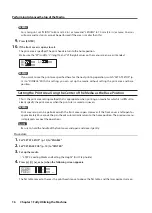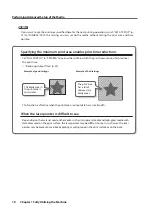
Important Points to Check before Printing
5
Chapter 1 Fully Utilizing the Machine
3 . A jig might be required depending on the size and shape of the object to be
printed on (the media) .
Depending on the size and shape of the object to be printed on (the media), the distance between the
object to be printed on (the media) and the print heads may increase, which will increase the likelihood of
ink mist occurring . In the direction of print heads movement, the object to be printed on (the media) or a jig
must be present in the area 40 mm (1 .6 in .) to both the right and left of the portion (width) of the data to be
printed . In this situation, the difference in height between the surfaces of the object to be printed on (the
media) and the jig must be less than 2 mm (78 .7 mil) .
"
"2 . Setting the Height of the Media Automatically" (First Step Guide)
"
“Setting the Height of the Media Manually” (p . 9)
"
“Height Settings When the Print Surface is Uneven” (p . 10)
When a jig is required:
•
The object to be printed on (the media) is not large enough to spread over the area 40 mm to both the right
and left of the portion (width) of the data to be printed .
•
The variation in height of the surface of the object to be printed on (the media) is 2 mm or more .
Print heads
Object to be printed on (media)
40 mm or longer
40 mm or longer
Flat table
Jig
Data
Less than 2 mm in
height difference from
the actual print surface
Print heads
Object to be printed on (media)
Flat table
Data
Jig
Less than 2 mm
from the highest
position
Jig
40 mm or longer
40 mm or longer
There are conditions for the height settings when the surface of the object to be printed on (the media) has a
height difference . For more information, refer to “Height Settings When the Print Surface is Uneven” (p . 10) .
























